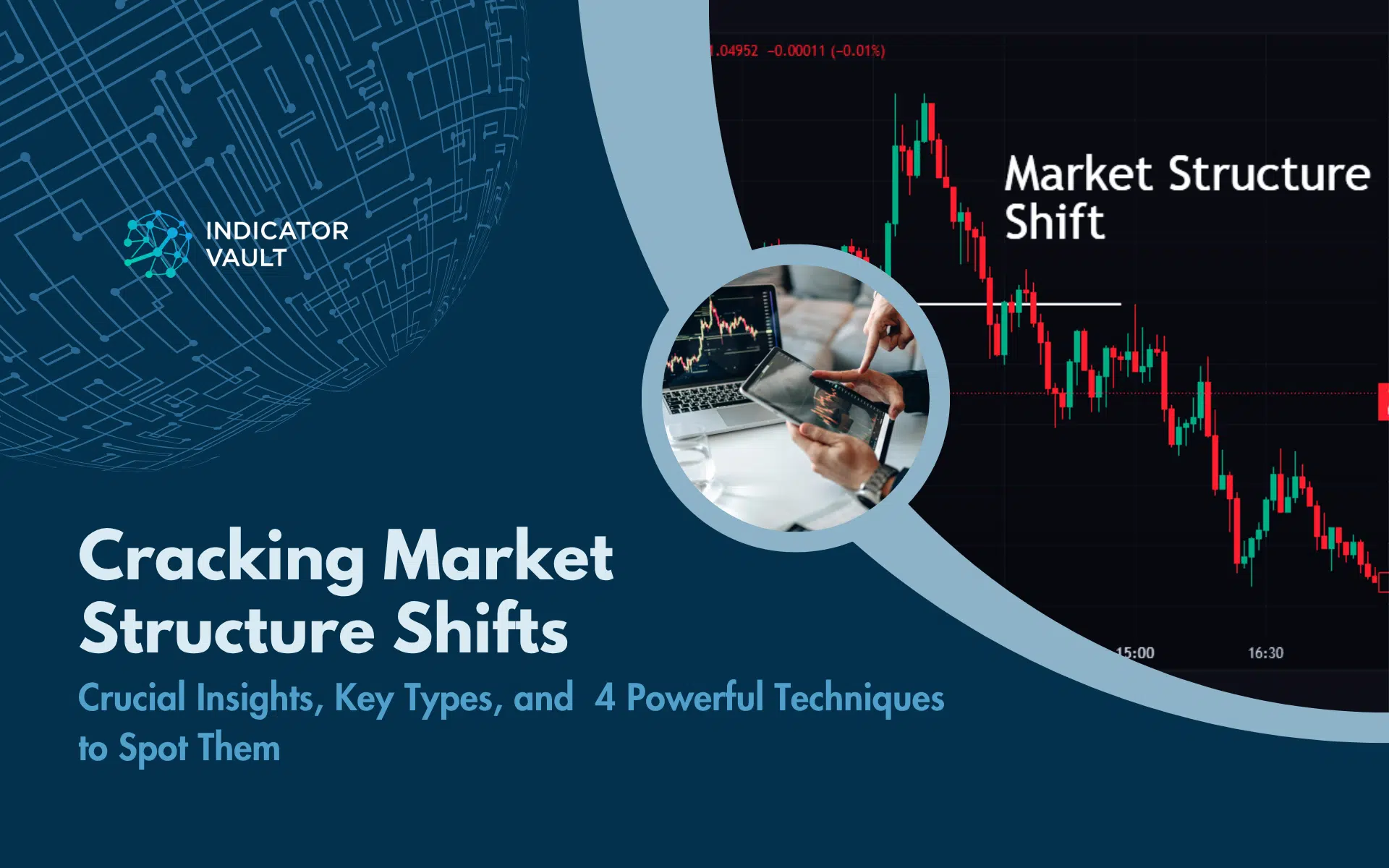Traders spend significant time & resources to master market structure shifts. Fortunately, this article summarizes the most salient points for every beginner.
Table of Contents
1. Introduction
The essence of a market structure shift in retail trading can’t be overstated. Traders spend significant time and resources to master the make-or-break concept. Fortunately, this article summarizes the most salient goal-oriented aspect to propel every beginner.
Continue reading to learn the definition, essence, and means of identifying market structure shifts like a professional. Traders of all experience levels will also gain exclusive access to one of the most powerful indicators predicated on this theory.
2. Meaning, Importance, and Types of Market Structure Shift
A market structure shift defines any significant price movement switch in a financial market. It is the point between one definable market condition and a different one.
Frequently, pro analysts express these conditions as trends or a consolidation (sideways). Thus, a structure shift means the switch from a downtrend/uptrend/consolidation to a different trend (or consolidation) in the market.

These shifts can be one of the following depending on the conditions:
- Bullish to Bearish Market Shift: The structure shifts from a bullish trend (uptrend) to a bearish one (downtrend). Higher swing highs define the former, unlike the lower with lower highs.
- Bearish to Bullish Market Shift: True to its name, this structure shift defines a market trend switch from bearishness to bullishness.
Trend-Consolidation Market Shifts: One of the market conditions (preceding or proceeding) in this type involves sideways movement. The market may move from a bearishness or bullishness to a ranging condition. Similarly, it can switch from such an uncertain condition to a trend.
Identifying market structure shifts has the following benefits:
- It signals the end of a contemporary trend and the beginning of a new one, which demands traders to strategize differently.
- A market shift significantly improves trade entry and exit timings. It ensures maximum profits across every market class.
- Traders can also better their risk management strategies with this knowledge based on ideal stop loss and take profit level.
- Proper utilization of these shifts is paramount for successful multi-timeframe analysis.
- As the recognition involves classifying one market condition from another, the knowledge helps traders avoid overtrading during consolidations.
- Sentiment analysts can consider the concept for more insights into the current and near-term overall market sentiment.
- Comprehending market structure shifts is essential for considering more advanced trading theories, such as Smart Money Concepts.
3. How to Identify Market Structure Shifts in 4 Quick Ways
A structure shift is the transition from one market condition to another. The former or latter may be bullishness, bearishness, or consolidation.
The basic definition opens a world of possibilities regarding recognition. However, below are a few of the most common methods today:
Trend Analysis
As discussed, an uptrend features higher highs, and downtrends feature lower highs. The highs and lows irregularly form during consolidations.
An inspection for a break in trends’ higher highs or lower lows sequences indicates a potential shift in market structure.
An increase or decrease in irregularity can also signify a structure switch to or from a consolidating market.
Chart and Candlestick Patterns
Several classical chart patterns and candlestick patterns suggest a market structure shift in technical analysis.
Some well-known ones are the double tops, double bottoms, head and shoulder patterns, and engulfing candles (bullish and bearish).
The market structure may remain unchanged after the patterns in some situations, but expectations for a shift are always high.
Key Level Violation
A market structure switch typically occurs after the price breaches a significant support or resistance level. Such levels can emerge from Fibonacci numbers, old highs & lows, Moving Averages, etc.
For instance, a bearish market breaching a key resistance level can signal the start of a bullish trend. Similarly, a bullish condition can turn bearish after the price breaks any significant support point.
Indicator Signals
Indicators provide the most diverse approach to identifying market structure switches in technical analysis. The Moving Average (MA), Relative Strength Index (RSI), and Moving Average Convergence Divergence (MACD) are a few practical options.
Some consider MA crossovers indicative enough, while others depend on the market movement from overbought or oversold levels on the RSI.
Combinations and infusions into more complex strategies also work.
4. Identifying Structure Shifts in the Financial Markets With Exceptional Precision
One of the most reliable techniques to spot market structure shifts involves indicators such as the RSI, MA, and MACD. Experts uniquely implement the classical tools singly or in combos for improved insights.
However, a cutting-edge solution, the Market Structure Shift for TradingView, provides a more seamless and stress-free approach.
It relies on swing highs and lows violations, which are almost always present during significant trend reversals. After the initial signal, the tool uses the Williams %R indicator to double-confirm the market shifts.

Concisely, below are a few of several benefits of its application:
- Earliest awareness of approaching reversals and structure shifts
- Improved trade entry and exit accuracy across all time frames
- Increased ease to boost one’s profitability in any desired financial market
- Assurance of taking every promising opportunity owing to the tool’s reliable alert system
Sounds unbelievable? Confirm these and many more advantages today.
5. Final Thoughts
A market structure shift is the transition from one market condition to another, which may be trending (up or down) or consolidating. Traders study these transitions extensively owing to their benefits in forecasts, risk management, and comprehension of complex trading techniques.
Chart analysis, classical patterns, and swing highs/lows violations are some of the most reliable ways to identify potential shifts.
Also, among the most recommended indicators is the Market Structure Shift for TradingView, utilizing key level breaks and other reliable data sources for high precision.
Please share this article with every trading enthusiast and leave feedback in the Comment Section for engaging discussions.













